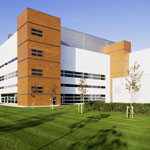The Question
Though not as glamorous as a theater or a museum, the office park, from a developmental standpoint, is perhaps the most effective anchor for a larger site. A good business park attracts good tenants, who attract good traffic, which attracts good residents, who attract good business, and so forth.
But what makes an office park “good”? For Andy Gallina, founder and president of Gallina Development Corporation, a Rochester, New York-based firm currently managing nearly 1.8 million square feet of office, warehouse, and flex space, quality is a matter of speculation. And, in the case of Cambridge Place, the company’s speculation was mostly focused on green features. “We decided that we would put our toe in the water and look at sustainable construction, with the intent of LEED certification,” he says. “In some of the larger markets, it’s not unusual for buildings to go this route, but in our market, it’s unheard of.”
The question became: would Gallina’s speculation of the market’s interest in green office space prove true?

The Development
In 2007, Gallina Development targeted two adjoining parcels of land on the south side of Rochester, at the intersection of South Winton Road and Interstate 590. Flanked on three sides by suburban residential developments and facing open land to the immediate west, the eventual site of Cambridge Place covered a total of 11.4 acres, with an existing two-story office building already on one of the parcels.
In the interest of developing it into a complex, Gallina constructed four new single-story buildings on the site, the two most recent of which—a 36,000-square-foot building and a 34,000-square-foot shell—are in the process of attaining LEED for Core and Shell certification. The completed five-building facility totals 145,000 square feet of rentable tenant space, and its eco-friendly measures were a calculated gamble.
In the past, smaller developers such as Gallina Development have been reticent to pursue sustainable construction or certification because of the additional costs. However, this time around, Gallina says, there was “a fairly tolerable payback window.” And, at the same time, he and his team wanted to find out if the people of Rochester would be willing to try out the new generation of sustainable buildings.
After completing the 36,000-square-foot structure, Gallina Development moved its own offices into Cambridge Place, occupying 6,000 square feet. The firm’s move provided curious potential tenants with a frame of reference for the advantages of relocating to a healthier office; among the space’s amenities are LED lighting and a geothermal mechanical system, both of which temper the office’s energy load.
The Leasing
The main idea behind the LEED certification system is the promotion of environmentally conscious construction, but another of the program’s major selling points is that companies can use it as a marketing tool. Some firms now even list certain levels of LEED certification as requirements for their office spaces. But, because sustainable buildings are sometimes more expensive, rents are also higher; when provided cheaper options, tenants will often look elsewhere.
Gallina says the certification of Cambridge Place’s first LEED building hasn’t explicitly attracted tenants, but the response has been positive for the new building (which saved the development firm around $628,000 thanks to federal tax incentives for building green). “It’s very unusual to build LEED-certified buildings on market speculation, but that’s what we did,” Gallina says.
Although tenants haven’t been rushing to fill spots, the firm believes that the difficulty of attracting new tenants in a slow economy might also be to blame, and those who are gradually filling the development are reaping immediate benefits. “By virtue of our investment as a developer,” Gallina says, “the end user’s energy costs will be reduced by between 20 to 40 percent, so there’s a payback for everyone.” ABQ


